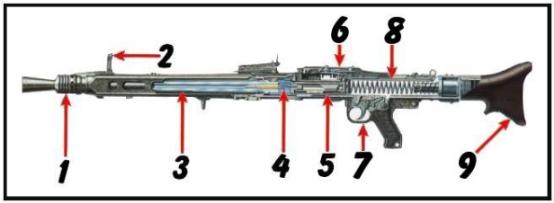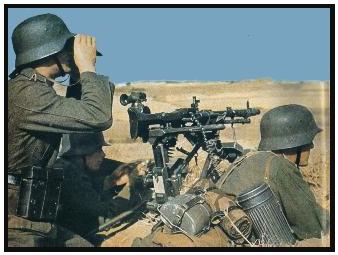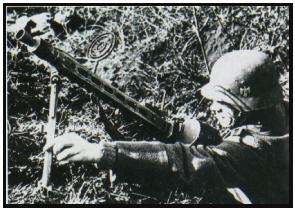Development
Germany produced many advanced weapons during World War II.Some were successful , some were unreliable , and some were a little too advanced for their own good.But a few German weapons were so good that they changed the face of warfare , and would influence weapons development all over the world for decades after Germany's defeat.Among their number were the MG-34 machine-gun and it's successor the MG-42.The first crude machine-guns were introduced in the 1860's but only came to dominate the battlefield during the first World War.By the time World War II broke out machine-guns in most armies came in a variety of forms.Types of MG
There were light machine-guns , sometimes little more them automatic rifles : equipped with bipods and generally magazine fed , they were carried and used by infantrymen to provide their own extra firepower.Then there were medium machine-guns : heavy often water cooled and mounted on massive tripods or mountings.These were used to lay down fire in the classic World War I manner : hosing out immense quantites of lead for long periods of time.Heavy machine-guns were also support weapons , operating over greater range and with greater penetration , but were even more unwieldy.The Wehrmacht was different.In the MG34 the Germans had produced the first general-purpose machine-gun , a weapon which could do just about anything.Fitted with a bipod , it could be used as a light machine-gun by infantry in the assault.Mounted on the MG-Lafatte , a tripod with a periscope sight it could be used in defence in the sustained fire role.When the gun fired the recoil moved the gun on the mount so that it automatically swept a beaten zone with fire.The tripod was designed so that the gunner could fire the weapon from below the parapet of the trench either by using a grip handle which had a mechanical linkage to the trigger or simply by pulling a cord fixed to the grip.Other mountings included twin and triple for AA use and with a heavier barrel sleeve and a ball mounting it was installed in tanks.
The MG34 was air cooled doing away with the clumsy water cooling systems which had formerly prevented the barrel from melting under sustained fire.To prevent overheating it was fitted with a quick-change barrel-MG crews always carried one or more spare barrels.It fitted a 7.92 mm round from a 50 round non disintegrating metal belt.As defensive armament in bombers it used 75-round saddle magazines.With a bipod the MG34 weighed around 12 kg loaded and 31 kg on the tripod.It was 1219 mm long , with a barrel length of 627 mm.The muzzle velocity was 755 meters a second.The maximum effective or combat range was 2000 meters and the MG34 had a cyclic rate of fire of 800 to 900 rounds per minute.The chief drawback of the gun was that it was built to very high standards , mostly with components machined or turned from solid billets of steel.This meant that it was labour intensive and very expensive to produce.
The expansion of the war into Russia saw a huge increase in demand for machine-guns.A team of engineers headed by Dr Grunow , a successful industrialist was tasked with finding ways of speeding up production of the MG34.The result was the classic MG-42 one of the most influential firearms in history.It used plastic in the butt and pistol grip and stamped and die cast metal components instead of expensive machined steel.In place of riveted or screwed joints spot welding was used.When Allied intelligence officers evaluated captured MG-42's they assumed that these changes were the result of pressure on the German munitions industry.They did not at first realize that it was a conscious design decision which had so simplified manufacture that machine-guns could be produced at a much greater rate , even with a semi-skilled work force.
|


